|
 Struebing has a Bachelor in Education with a major in
botany and a minor in zoology. Struebing is a former business owner
in New Holland having been part owner of the farm equipment
dealership in that community. He is involved with the Logan County
Master Naturalist program and enjoys traveling. Struebing has
traveled to many foreign countries and enjoys observing what nature
has to offer in those faraway lands. Struebing has a Bachelor in Education with a major in
botany and a minor in zoology. Struebing is a former business owner
in New Holland having been part owner of the farm equipment
dealership in that community. He is involved with the Logan County
Master Naturalist program and enjoys traveling. Struebing has
traveled to many foreign countries and enjoys observing what nature
has to offer in those faraway lands.
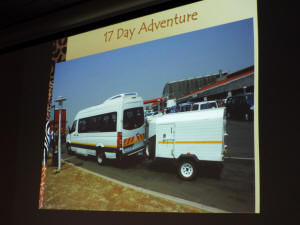
On Saturday, Struebing shared stories and photos from
his trip to South Africa. The 17-day trip included 15 days with feet
on the ground all through South Africa. Struebing spoke about the
numerous regions within South Africa and gave examples of how the
regions differ in their native plant life.
Guests were so engrossed in the program that the scheduled 45-minute
session flew by.
Struebing explained that the trip included visits to each region.
Most notable he said was the change in nature within the various
regions. He showed slides of the agricultural areas within South
Africa as well as the mountainous and the lush “Cape” regions that
host a wide variety of the more tropical style flora. Photos
included wildlife in the region many roads the group traveled
sported beautiful flowering plants like Bottlebrush along the
shoulders.
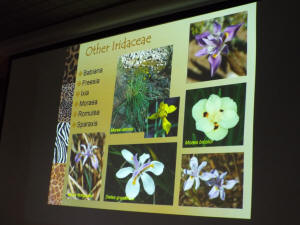
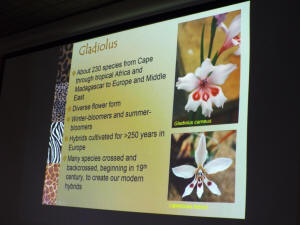
Some of the interesting points Struebing brought up included the
fact that there are plants within the South Africa region that are
actually the ancestors to plants we enjoy and know very well right
in central Illinois. Examples of this are the Iris, geranium and the
gladiola. While some don’t look much like the plants we enjoy here
at home, there are still some similarities that Struebing was able
to point out to the audience. The Iris and gladiola are members of
the geophyte’s vegetation type in South Africa are in the Iridaceae
and Gladiolus plant families respectively.

There are also many succulent varieties growing on the terrain in
regions of South Africa. In his photos, Struebing showed several of
these succulents and those who had attended the earlier workshop by
Culver instantly noticed the similarities between what Struebing saw
in Africa and what Culver grows here in Illinois.
In South Africa, geraniums are a member of Pelargonium plant family
and grow in the wild as shrubs.
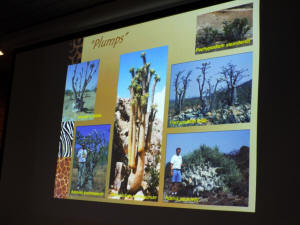
Another interesting plant that grows in the region is
part of the Baobabs family. These large succulent plants grow as
tall as trees but then host very large “trunks” for water storage.
These plants are often referred to as “plumps” because their trunks
or bases are disproportionately larger than the foliage at their
tops.
A humorous section of Struebing’s slideshow was the pictures he
presented on the stone plants. Struebing explained that the stone
plants grow very small and close to the ground on rocky terrain.
Walking across such terrain, one can easily miss the fact he or she
is walking on and crushing the tiny plants. Great care has to be
taken when exploring and seeking out those plants.
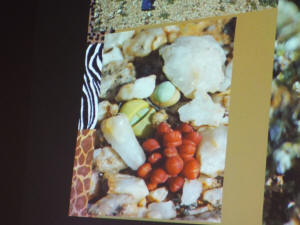
Struebing showed some pictures of odd little objects that looked
like something out of a science fiction-other-world movie. Then he
brought everything into perspective as he noted one tiny little
stone plant and said that the favorite nickname for the plant was
“baby bottom.” Sure enough, when thinking of that name, one can
easily see the “cheeks” of the tiny tot peeking out of a diaper.
[to top of second column] |

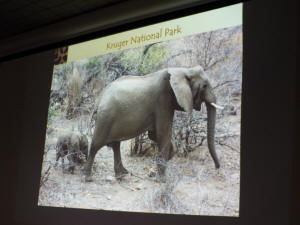
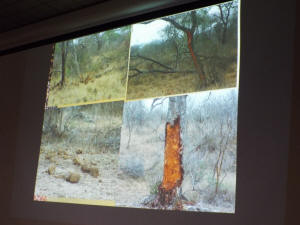
One of the perils to plants in South Africa is the
wildlife, particularly elephants. Struebing showed photos of trees
where that the bark and much of the tree trunk have been completely
destroyed. He explained that this is being done by the elephants as
they search for food and moisture. He explained that in some parts
of the country it is so arid that there is no water and plant life
dies quickly. In searching for their nourishment, the elephants eat
the trees.

Struebing also talked about the many parks and botanical garden
areas throughout South Africa and shared photos of gardens and
nature reserves that had been included in the tour. He reported that
sadly on the day they visited Table Mountain it was sleeting. The
only way to the top of the mountain is via a tram that goes almost
straight up. The tram was shut down because of the sleet, so he did
not get to make the trip to the top.
Struebing also shared that because South Africa is below the
equator, there is a reversal in the seasons. So, while he was there,
it was South Africa’s early spring, similar to our late March. There
were several chilly days, even icy temperatures and precipitation.
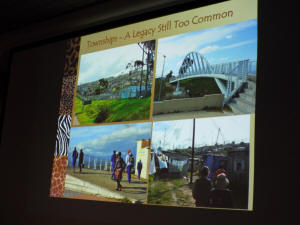
As Struebing concluded his talk, he included a couple
of slides showing the “townships” that exist in South Africa. He
explained that there is a dramatic separation of races. Though
“apartheid” officially no longer exists in South Africa, Struebing
said it is still in practice through racial segregation and
separation. He noted there are three racial classes – whites,
coloreds, and blacks. To differentiate, he said that those called
“coloreds” are those of mixed race. Those belonging to the black
race are still living in segregated ‘townships’ under deplorable
conditions. He noted that the township his group visited held 7,000
people. They lived in small shacks made from discarded lumber,
cardboard, old billboards and other scrap materials. There was only
walking space between the dwellings, and shared outhouses were their
only source of human waste disposal. That particular township he
said had a total of ten public water hydrants for the total
population.
Struebing said that the “Mandella Houses” (named after Nelson
Mandella) that were built to assist these people had been very slow
catching on because, while the government had provided a suitable
home structure, those who were intended to occupy the structures did
not have the furnishings they needed to live in actual homes. Over
time, that is changing and the houses are being utilized, but he
said there is still much to be done to improve the living conditions
of the ‘black’ race in South Africa.

He finished saying that finishing that particular tour and returning
to a very nice hotel room overlooking the South Africa coast, which
is absolutely beautiful, it was somewhat disturbing to think that
just a few miles away people were living in such terrible poverty.
While Struebing could have probably talked longer, and his guests
could have listened as intently as they did in the first few
minutes, the 45 minute session came to an end, running over by only
a couple of minutes. Everyone then moved on to the last hour of the
day featuring the keynote speaker Dr. Julia Ossler of Lincoln
College.
[Nila Smith] |